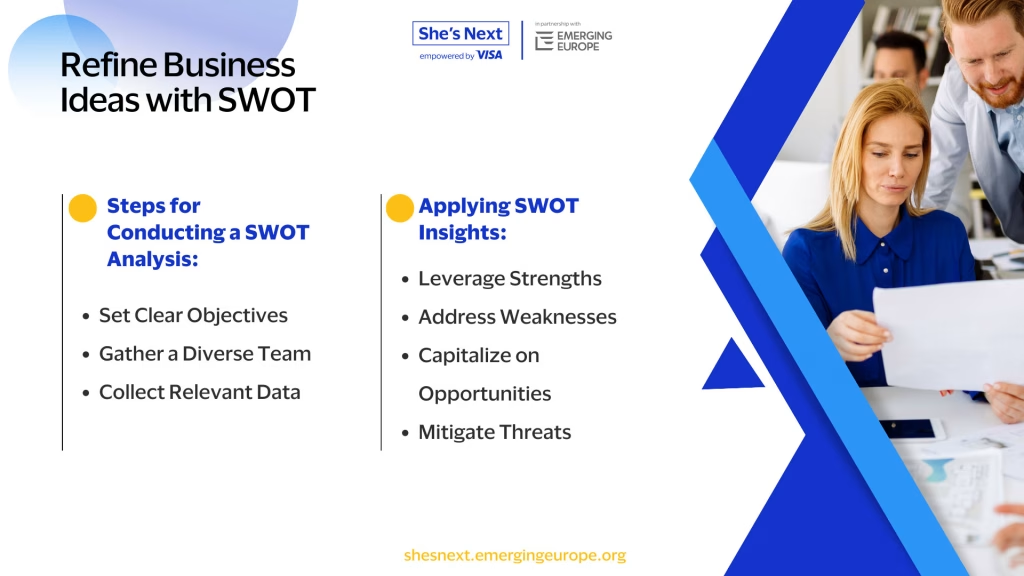
How to Use SWOT Analysis to Refine Business Ideas: A Practical Guide
Refining business ideas is crucial for ensuring their relevance and viability in a competitive market.
This article will demonstrate how to use SWOT analysis—a strategic planning tool that evaluates Strengths, Weaknesses, Opportunities, and Threats—to enhance your business ideas effectively.
Understanding SWOT Analysis
SWOT analysis is a framework used to assess the internal and external factors that could impact your business’s success.
It helps in structured assessment, improves strategic planning, and identifies potential areas for growth and improvement.
Preparing for a SWOT Analysis
Set Clear Objectives
Define the specific goals you aim to achieve with your SWOT analysis.
Write a concise objective statement to focus the analysis, such as, ‘Our goal is to refine our new product idea for better market fit’.
Gather a Diverse Team
Bringing together team members from different departments enhances the diversity of perspectives and expertise, which enriches the analysis.
Assemble a team that includes members from marketing, sales, product development, and finance to cover all angles of the business idea.
Collect Relevant Data
Accurate data is crucial for effective analysis. Utilize market research reports, customer feedback, and competitive analysis to gather comprehensive data about the product and its environment.
For instance, collect and analyse customer feedback on the product idea to understand their needs and preferences.
Conducting the SWOT Analysis
Identify Strengths
Recognize the internal attributes that give your business idea a competitive advantage. List strengths such as a strong brand reputation, unique product features, or high customer demand that can be leveraged to dominate the market.
For a handmade jewellery business, strengths might include unique designs, high-quality materials, and a loyal customer base.
Identify Weaknesses
Acknowledge internal areas where the business idea needs improvement. Identify weaknesses like a limited budget, lack of expertise in a crucial technology, or inefficient distribution channels that could hinder success.
For a boutique bakery, weaknesses could be limited production capacity, lack of online presence, and high ingredient costs.

Identify Opportunities
Look for external factors that could positively impact your business idea. List potential opportunities such as emerging market trends for eco-friendly products or technological advancements that your business could exploit to gain an edge.
For an online coaching service, opportunities might include increasing demand for remote learning and support, as well as expanding markets where such services are less common.
Identify Threats
Consider external challenges that could pose risks to the success of your business idea. Identify threats such as economic downturns, new competitors, or changes in regulations that require strategic preparation to mitigate.
For a fashion start-up focusing on sustainable clothing, threats might include economic downturns affecting consumer spending and regulatory changes related to textile production.
Analysing and Refining Business Ideas
Leverage Strengths
Use your identified strengths to enhance the business idea. Focus marketing efforts on your strong brand reputation to differentiate your product in the marketplace.
A fitness app with a large user base and high engagement rates can leverage these strengths by highlighting user testimonials and success stories in marketing campaigns.
Address Weaknesses
Create strategies to improve or eliminate weaknesses. Invest in technology training for team members or allocate more budget to develop stronger distribution channels.
A small local café struggling with limited seating might explore offering delivery services or expanding its space to attract more customers.
Capitalize on Opportunities
Align your business strategies to take full advantage of identified opportunities. Develop new eco-friendly product lines to tap into the growing market demand for sustainable goods.
A skincare brand can introduce a new line of organic products to appeal to the increasing number of consumers seeking natural beauty solutions.
Mitigate Threats
Prepare to face potential external challenges with proactive strategies. Diversify product offerings and explore new markets to reduce dependency on volatile sectors.
A travel agency facing economic uncertainty and travel restrictions can diversify by offering virtual travel experiences or focusing on local tourism packages.
A SWOT analysis is not a one-time activity but an ongoing process that should be revisited regularly as your business and the external environment evolve.
Start by conducting a SWOT analysis today and use the insights gained to turn potential challenges into actionable strategies for success.
New Free Courses — Made for Ambitious Women Entrepreneurs!
It’s time to grow smarter, adapt faster, and take your business global.
Explore two powerful courses available exclusively to She’s Next members:
The Reinvention Masterclass for Start-up Founders
Beyond Borders: Building for Global Success
Enroll today — it’s free!






Responses